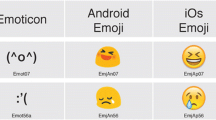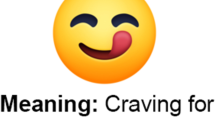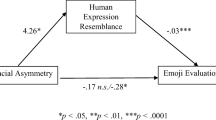Abstract
Emoji faces are ubiquitous and integrated into most people’s everyday (nonverbal) vernacular. Yet, we know little about how people interpret these characters in terms of their emotional content. Do people agree that an emoji face represents an individual emotion and that it is unique to a specific emotion? Are such representations similar across electronic platforms? The present study took a theoretical approach to address these questions by investigating shared agreement between emoji–emotion pairings across three electronic platforms (Apple, Android, and Samsung). Two hundred twenty-eight English-speaking adults completed an online survey that involved picking up to three emoji faces (presented from a common set from one of three platforms) for each of 10 emotions. They then indicated the strength of that relationship. We examined whether the intensities that participants gave to emoji–emotion pairings were specific and consistent across platforms. Our results showed limited shared agreement for the majority of emoji–emotion pairings, and significant variation as to which emotion category a “comparable” emoji belonged depending upon the viewed platform. We highlight the need for future emoji perception research to examine how different platform renderings of the same emoji might lead to miscommunication and interpretation discrepancies.






Similar content being viewed by others
Notes
There were two exceptions to this rule: We decided to keep Samsung’s confounded-face emoji and the worried-face emoji even though these particular emojis had an embellishment. In these cases, we removed the embellishments with Photoshop.
A forced-choice task is less reflective of a natural choice task (e.g. participants are forced to assign one emoji face to an emotion category). Therefore, any “universal” findings might result from the restrictive design.
References
Aviezer, H., Bentin, S., Dudarev, V., & Hassin, R. R. (2011). The automaticity of emotional face-context integration. Emotion,11(6), 1406.
Aviezer, H., Hassin, R. R., Ryan, J., Grady, C., Susskind, J., Anderson, A., et al. (2008). Angry, disgusted, or afraid? Studies on the malleability of emotion perception. Psychological Science,19(7), 724–732.
Aviezer, H., Trope, Y., & Todorov, A. T. (2012). Body cues, not facial expressions, discriminate between intense positive and negative emotions. Science,338(6111), 1225–1229. https://doi.org/10.1126/science.1224313.
Barrett, L. F. (2006a). Are emotions natural kinds? Perspectives on Psychological Science,1(1), 28–58. https://doi.org/10.1111/j.1745-6916.2006.00003.x.
Barrett, L. F. (2006b). Solving the emotion paradox: Categorization and the experience of emotion. Personality and Social Psychology Review,10(1), 20–46. https://doi.org/10.1207/s15327957pspr1001_2.
Barrett, L. F. (2011). Was Darwin wrong about emotional expressions? Current Directions in Psychological Science,20(6), 400–406. https://doi.org/10.1177/0963721411429125.
Barrett, L. F. (2012). Emotions are real. Emotion,12(3), 413–429. https://doi.org/10.1037/a002755.
Barrett, L. F. (2014). The conceptual act theory: A précis. Emotion Review,6(4), 292–297.
Barrett, L. F. (2017). How emotions are made: The secret life of the brain. Boston, MA: Houghton Mifflin Harcourt.
Barrett, L. F., Adolphs, R., Marsella, S., Martinez, A. M., & Pollak, S. D. (2019). Emotional expressions reconsidered: Challenges to inferring emotion from human facial movements. Psychological Science in the Public Interest,20(1), 1–68. https://doi.org/10.1177/1529100619832930.
Barrett, L. F., Lindquist, K. A., & Gendron, M. (2007). Language as context for the perception of emotion. Trends in Cognitive Sciences,11(8), 327–332.
Brosch, T., Pourtois, G., & Sander, D. (2010). The perception and categorisation of emotional stimuli: A review. Cognition and Emotion,24(3), 377–400. https://doi.org/10.1080/02699930902975754.
Calvo, M. G., & Nummenmaa, L. (2008). Detection of emotional faces: Salient physical features guide effective visual search. Journal of Experimental Psychology: General,137(3), 471–494.
Carlson, J. R., & Zmud, R. W. (1999). Channel expansion theory and the experiential nature of media richness perceptions. Academy of Management Journal,42(2), 153–170.
Cha, Y. J. (2007). Identifying cross-cultural differences of emoticons in computer-mediated communication: A comparison of North American and South Korean emotional responses to emoticons. Thesis for the master of science in human-computer interaction, Indiana University. http://hdl.handle.net/1805/2351.
Coelho, C. M., Cloete, S., & Wallis, G. (2009). The face-in-the-crowd effect: When angry faces are just cross. Journal of Vision,10(1), 7.
Cordaro, D. T., Sun, R., Keltner, D., Kamble, S., Huddar, N., & McNeil, G. (2018). Universals and cultural variations in 22 emotional expressions across five cultures. Emotion,18(1), 75. https://doi.org/10.1037/emo0000302.
Cowen, A. S., & Keltner, D. (2017). Self-report captures 27 distinct categories of emotion bridged by continuous gradients. Proceedings of the National Academy of Sciences,114(38), E7900–E7909.
de Waal, F. B. M. (2003). Darwin’s legacy and the study of primate visual communication. In P. Ekman, J. J. Campos, R. J. Davidson, & F. B. M. De Waal (Eds.), Emotions inside out: 130 years after Darwin’s the expression of the emotions in man and animals (pp. 7–31). New York, NY: The New York Academy of Sciences.
Derks, D., Bos, A. E., & Von Grumbkow, J. (2008). Emoticons in computer-mediated communication: Social motives and social context. Cyber Psychology and Behavior,11(1), 99–101.
Ekman, P. (1992). Are there basic emotions? Psychological Review,99, 550–553.
Ekman, P. (1993). Facial expression and emotion. American Psychologist,48, 384–392.
Ekman, P. (2016). What scientists who study emotion agree about. Perspectives on Psychological Science,11(1), 31–34. https://doi.org/10.1177/1745691615596992.
Ekman, P., & Rosenberg, E. L. (Eds.). (1997). What the face reveals: Basic and applied studies of spontaneous expression using the Facial Action Coding System (FACS). Oxford: Oxford University Press.
Emojipedia. (2018).
 Emojipedia—
Emojipedia—
 home of Emoji meanings
home of Emoji meanings
 . Retrieved from http://emojipedia.org/.
. Retrieved from http://emojipedia.org/.Esteves, F., Dimberg, U., & Öhman, A. (1994). Automatically elicited fear: Conditioned skin conductance responses to masked facial expressions. Cognition and Emotion,8(5), 393–413.
Fox, E., Lester, V., Russo, R., Bowles, R. J., Pichler, A., & Dutton, K. (2000). Facial expressions of emotion: Are angry faces detected more efficiently? Cognition and Emotion,14(1), 61–92.
Fugate, J. M., & Barrett, L. F. (2014). The role of language on the perception and experience. In T. Holtgraves (Ed.), The Oxford handbook of language and social psychology (pp. 28–294). New York, NY: Oxford University Press.
Fugate, J. M. B., & Franco, C. L. (solicited). A review of electronic facial expression research and its relationship to “basic” emotions. In Frontiers in psychology: Advances and obstacles in contemporary nonverbal communication research.
Gudykunst, W. B. (1997). Cultural variability in communication: An introduction. Human Communication Research,24(4), 327–348. https://doi.org/10.1177/009365097024004001.
Hansen, C. H., & Hansen, R. D. (1988). Finding the face in the crowd: An anger superiority effect. Journal of Personality and Social Psychology,54(6), 917.
Izard, C. E. (1991). The psychology of emotions. New York, NY: Plenum Publishing.
Izard, C. E. (1994). Innate and universal facial expressions: Evidence from developmental and cross-cultural research. Psychological Bulletin,115(2), 288–299.
Izard, C. E. (2013). Human emotions. New York, NY: Springer.
Kelly, C. (2015). Do you know what I mean >:(: A linguistic study of the understanding of emoticons and emoji in text messages. Retrieved November 12, 2015 from http://www.diva-portal.org/.
Keltner, D., Sauter, D., Tracy, J., & Cowen, A. (2019). Emotional expression: Advances in basic emotion theory. Journal of Nonverbal Behavior,43(2), 133–160.
Kendall, M. G., & Smith, B. B. (1939). The problem of m rankings. The Annals of Mathematical Statistics,10(3), 275–287.
Kennedy, P. (2014). Who made that emoticon? Retrieved August 26, 2014, from http://www.nytimes.com/2012/11/25/magazine/who-made-that-emoticon.html.
Kupperbusch, C., Matsumoto, D., Kooken, K., Loewinger, S., Uchida, H., Wilson-Cohn, C., et al. (1999). Cultural influences on nonverbal expressions of emotion. In P. Philippot, R. S. Feldman, & E. J. Coats (Eds.), The social context of nonverbal behavior (pp. 17–44). Cambridge, MA: Cambridge University Press.
Lebduska, L. (2014). Emoji, emoji, what for art thou? Retrieved November 12, 2014, from http://harlotofthearts.org/index.php/harlot/article.
LeDoux, J. (1996). Emotional networks and motor control: A fearful view. Progress in Brain Research,107, 437–446.
LeDoux, J. (2003). The emotional brain, fear, and the amygdala. Cellular and Molecular Neurobiology,23(4–5), 727–738.
Lindquist, K. A., & Gendron, M. (2013). What’s in a word? Language constructs emotion perception. Emotion Review,5(1), 66–71. https://doi.org/10.1177/1754073912451351.
Ling, R. (2010). Texting as a life phase medium. Journal of Computer-Mediated Communication,15(2), 277–292. https://doi.org/10.1111/j.1083-6101.2010.01520.
Liu, D., & Yang, C. C. (2016). Media niche of electronic communication channels in friendship: A meta-analysis. Journal of Computer-Mediated Communication,21(6), 451–466. https://doi.org/10.1111/jcc4.12175.
Lo, S. K. (2008). The nonverbal communication functions of emoticons in computer-mediated communication. Cyber Psychology and Behavior,11(5), 595–597. https://doi.org/10.1089/cpb.2007.0132.
Lu, X., Ai, W., Liu, X., Li, Q., Wang, N., Huang, G., et al. (2016). Learning from the ubiquitous language: An empirical analysis of emoji usage of smartphone users. Journal of Cross-Cultural Psychology,20(1), 92–105. https://doi.org/10.1145/2971648.2971724.
Matsumoto, D. (1989a). Cultural influences on the perception of emotion. Journal of Cross-Cultural Psychology,20(1), 92–105. https://doi.org/10.1177/0022022189201006.
Matsumoto, D. (1989b). Face, culture, and judgments of anger and fear: Do the eyes have it? Journal of Nonverbal Behavior,13(3), 171–188. https://doi.org/10.1007/BF00987048.
Matsumoto, D., Keltner, D., Shiota, M. N., Sullivan, M., & Frank, M. (2008). Facial expressions of emotion. In M. Lewis, J. M. Haviland-Jones, & L. F. Barrett (Eds.), Handbook of emotions (3rd ed., pp. 211–234). New York, NY: The Guildford Press.
Miller, H., Thebault-Spieker, J., Chang, S., Johnson, I., Terveen, L., & Hecht, B. (2016). Blissfully happy or ready to fight: Varying interpretations of emoji. In Tenth international AAAI conference on web and social media. International conference on weblog and social media (pp. 259–268).
Nakano, M. (2015). Why and how I created emoji—IGNITION. Retrieved November 11, 2015, from http://ignition.co/105.
Novak, P., Smailović, J., Sluban, B., & Mozetič, I. (2015). Sentiment of emoji. PLOS ONE,10(12), e0144296. https://doi.org/10.1371/journal.pone.0144296.
Öhman, A. (2005). The role of the amygdala in human fear: Automatic detection of threat. Psychoneuroendocrinology,30(10), 953–958. https://doi.org/10.1016/j.psyneuen.2005.03.019.
Oleszkiewicz, A., Frackowiak, T., Sorokowska, A., & Sorokowski, P. (2017). Children can accurately recognize facial emotions from emoticons. Computers in Human Behavior,76, 372–377. https://doi.org/10.1016/j.chb.2017.07.040.
Parr, L. A., Waller, B. M., Vick, S. J., & Bard, K. A. (2007). Classifying chimpanzee facial expressions using muscle action. Emotion,7(1), 172. https://doi.org/10.1037/1528-3542.7.1.172.
Plutchik, R. (1980). A general psychoevolutionary theory of emotion. In R. Plutchik & H. Kellerman (Eds.), Theories of emotion (pp. 3–33). New York: NY, Academic Press.
Quintana, L. (2014). Cultural differences in style and usage of emoticons in computer-mediated communication. International Conference on Weblog and Social Media,16, 1–35.
Reynolds, R. M., Novotny, E., Lee, J., Roth, D., & Bente, G. (2019). Ambiguous bodies: The role of displayed arousal in emotion [mis] perception. Journal of Nonverbal Behavior,31, 1–20.
Riordan, M. A. (2017). Emojis as tools for emotion work: Communicating affect in text messages. Journal of Language and Social Psychology,36(5), 549–567.
Sauter, D. A., LeGuen, O., & Haun, D. (2011). Categorical perception of emotional facial expressions does not require lexical categories. Emotion,11(6), 1479–1483.
SwiftKey. (2015). Most-used emoji revealed: Americans love skulls, Brazilians love cats, the French love hearts [blog]. http://swiftkey.com/en/blog/americans-love-skulls-brazilians-love-cats-swiftkey-emoji-meanings-report/.
Thompson, D., & Filik, R. (2016). Sarcasm in written communication: Emoticons are efficient markers of intention. Journal of Computer-Mediated Communication,21(2), 105–120. https://doi.org/10.1111/jcc4.12156.
Tigwell, G. W., & Flatla, D. R. (2016). Oh that’s what you meant!: Reducing emoji misunderstanding. In Proceedings of the 18th international conference on human-computer interaction with mobile devices and services adjunct (pp. 859–866).
Tipples, J., Atkinson, A. P., & Young, A. W. (2002). The eyebrow frown: A salient social signal. Emotion,2(3), 288–296.
Tomkins, S. S. (1962). Affect, imagery, consciousness. The positive affects (Vol. 1, pp. 120–131). New York, NY: Springer.
Toratani, Y., & Hirayama, M. J. (2011). Psychological analysis of emoticons used for e-mails on cellular phones. International Conference on Mobile IT Convergence,2(8), 49–53.
Troiano, G., & Nante, N. (2018). Emoji: What does the scientific literature say about them? A new way to communicate in the 21th century. Journal of Human Behavior in the Social Environment,28(4), 528–533.
Trope, Y. (1986). Identification and inferential processes in dispositional attribution. Psychological Review,93(3), 239.
Unicode: Full Emoji List. (2018). Retrieved March 3, 2018, from https://unicode.org/emoji/charts/full-emoji-list.
Van Hooff, J. A. R. M. (1962). Facial expressions in higher primates. Symposia of the Zoological Society of London,8, 97–125.
Williams, M. A., & Mattingley, J. B. (2006). Do angry men get noticed? Current Biology,16(11), 402–404.
Wolny, W. (2016). Sentiment analysis of Twitter data using emoticons and emoji ideograms. Studia Ekonomiczne,296, 163–171.
Acknowledgements
We would like to thank A. Scott McCauley for help with programming the survey. We would also like to thank Tatum Leclair and Maatangi Krishna who helped code the data. Finally, we would like to thank Aminda O’Hare and Mahzad Hojjat for assistance with the emoji selection.
Funding
This work was supported by the Office of Undergraduate Research at the University of Massachusetts-Dartmouth to Courtny Franco.
Author information
Authors and Affiliations
Corresponding author
Additional information
Publisher's Note
Springer Nature remains neutral with regard to jurisdictional claims in published maps and institutional affiliations.
Electronic supplementary material
Below is the link to the electronic supplementary material.
Rights and permissions
About this article
Cite this article
Franco, C.L., Fugate, J.M.B. Emoji Face Renderings: Exploring the Role Emoji Platform Differences have on Emotional Interpretation. J Nonverbal Behav 44, 301–328 (2020). https://doi.org/10.1007/s10919-019-00330-1
Published:
Issue Date:
DOI: https://doi.org/10.1007/s10919-019-00330-1





 Emojipedia—
Emojipedia—
 home of Emoji meanings
home of Emoji meanings
 . Retrieved from
. Retrieved from